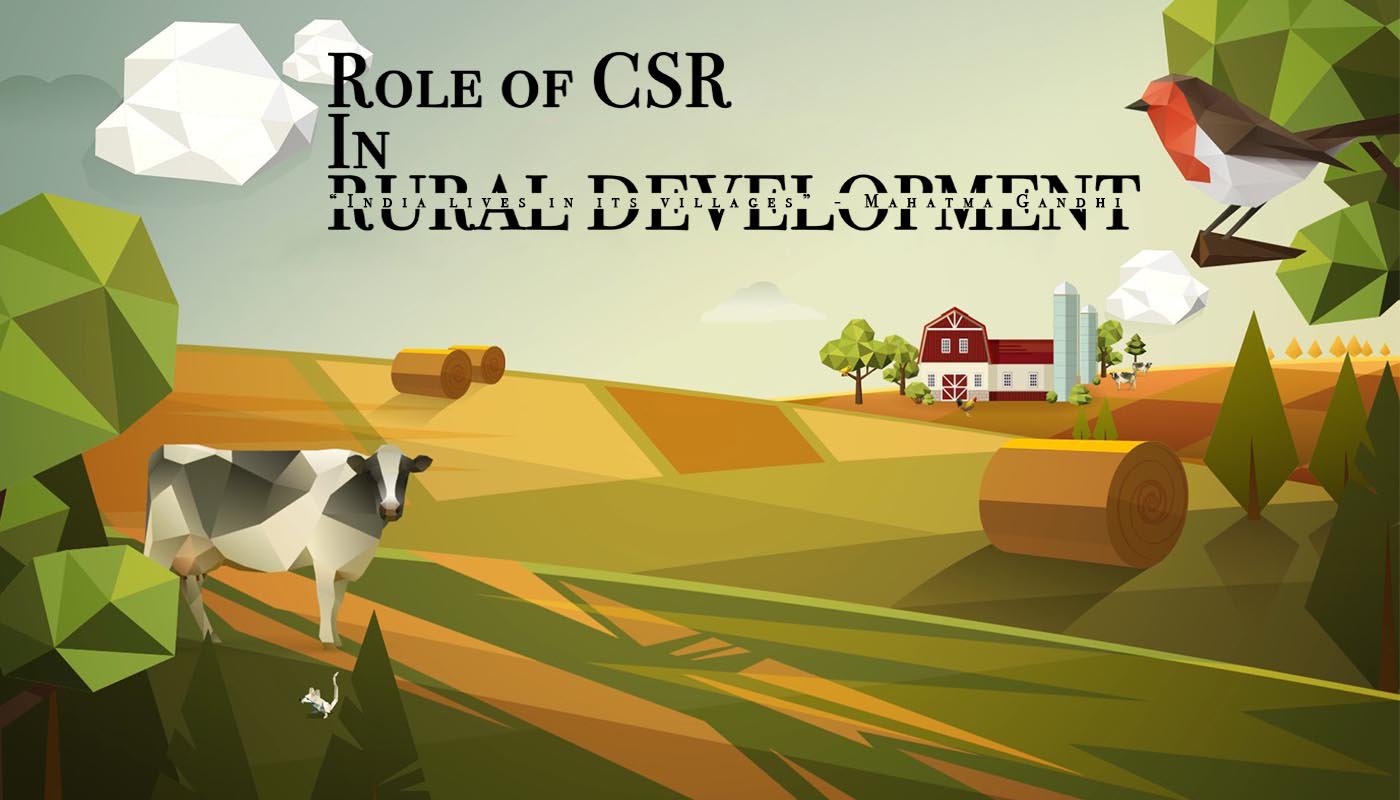“India lives in its villages” – Mahatma Gandhi
As the quote point outs that most of the Indian population lives in the rural areas , India cannot be considered as a developed Country without reinforcing the growth efforts of the rural areas.
Role of CSR in Rural development
Introduction-
A Rural Area or countryside is a large geographical area with low population density that is located outside towns and cities. Everything that is un-urban is considered as rural. Typical rural areas have small settlements.
Rural Development & Its Significance
Rural Development is the methodology which involves the Upgradation of the social, economic, and cultural conditions of a village or small town.
Our economy is developing speedily, corporate sector is going globalized, liberalization is leading to tremendous change in Industries, Information Technology & Service sector, but nobody is bothered to think about accelerating the rural development and making it as fast as in these sectors.
Benefiting to 35% of the total population, already developed and above poverty line can’t be considered as an important yardstick of development.
Aims of Rural Development
To BUILD – Infrastructure, Public service & Communication
To IMPROVE –Education, Health & Living condition.
To GENERATE –Employment, Farm & Storage & Economical activities
Problems Of Rural Areas:-
About 50-60% of rural population in India lives in primitive conditions. This abject state exists even after 70 years of independence. Thus Rural Development programs are critically required in the present condition also. There are many hindrances in the rural development programs. Such as :-
- Many villages lack in electrical/power supply.
- Literacy is the major problem in rural development program.
- Till date many rural households are dependent on the primitive methods of cooking, living and farming.
- Usage of primitive cook stoves, leads to deaths of more than 2 lakh people every year due to pollution.
- 54% of India’s population is below 25 years and most of them live in rural areas and are unemployed.
- Rural people are ignored even by the policy makers and planners. Even if they make plans and policies for betterment of the rural development, the implementation lacks swiftness.
- Privatization concept is useful for rural development but, government is not paying much attention to this aspect.
PEOPLE RELATED PROBLEMS
Traditional way of thinking.
Poor understanding.
Low level of education to understand developmental efforts and new technology.
Deprived psychology and scientific orientation.
Poor awareness.
Existence of unfelt needs.
AGRICULTURE RELATED PROBLEM
Lack of expected awareness, knowledge, skill and attitude.
Poor marketing facility.
Small size of landholding.
Division of land.
Unwillingness to work and stay in rural areas.
PROBLEMS RELATES INFRASTRUCTURAL
Poor infrastructure facilities like :-
- Water
- Electricity
- Transport
- Educational institutions
- Communication
- Health
- Employment
- Storage facility etc.
ECONOMIC PROBLEMS
- Unfavorable economic condition to adopt high cost technology.
- High cost of inputs.
- Underprivileged rural industries.
PROBLEM RELATED TO LEADERSHIP
- Leadership among the hands of inactive and incompetent people.
- Self Interest of leaders.
- Biased political will.
PROBLEMS RELATED TO ADMINISTRATION
- Political interference.
- Lack of motivation and interest.
3.Unwillingness to work in villages.
- Improper utilization of budget.
- No proper monitoring of programs and lack of their implementation.
Programs Initiated By Government Of India To Deal With These Problems:-
- Deen Dayal Upadhyaya Gram Jyoti Yojana
- DDUGJY is a Government of India scheme designed to provide continuous power supply to rural India. It is one of the key initiatives of the NDA government 2014-2019.
- Funding by the Govt. – The government plans to invest ₹756 billion (US$12 billion) for rural electrification under this scheme. The scheme replaces the Rajiv Gandhi Grameen Vidyutikaran Yojana (RGGVY).
- Aim – The DDUGJY scheme will enable to initiate much awaited reforms in the rural areas. It focuses on feeder separation (rural households & agricultural) and strengthening of sub-transmission & distribution infrastructure including metering at all levels in rural areas. This will help in providing round the clock power to rural households and adequate power to agricultural consumers .The earlier scheme for rural electrification viz. Rajiv Gandhi Grameen Vidyutikaran Yojana (RGGVY) has been subsumed in the new scheme as its rural electrification component.
Role of CSR in DDUGJY– CSR can help the government in providing additional funds and proper assistance in the implementation of the yojana as the deadline(May,2017) for this project was missed and there are still 5150 villages yet to be electrified. CSR can also help in contributing to strengthen the supply distribution network.
- Pradhan Mantri Adarsh Gram Yojana
- PMAGY is a rural development program launched by the Central government in India in the financial year 2009–10 for the development of villages having a higher ratio (over 50%) of people belonging to the scheduled castes through convergence of central and state schemes and allocating financial funding on a per village basis.
- Aim of the plan is to build an “Adarsh Gram” (Model village) which has adequate physical and institutional infrastructure, in which minimum needs of all sections of the society are fully met. The village which is progressive and dynamic and its residents live in harmony. All the facilities necessary for dignified living should be available and the residents are enabled to utilize their potential to the fullest.
- Allocation of funds by Govt.- In the launching phase, the Centre had allocated a sum of ₹555.4 million (US$8.7 million) to Assam, Bihar and Rajasthan. As a pilot project the program was implemented in 1,000 villages in Assam, Bihar, Himachal Pradesh, Rajasthan and Tamil Nadu with an allocation of ₹1 billion (US$16 million) with each village to get ₹1 million (US$16,000) per year.
In September 2011 the annual funding on the project was raised to ₹2 million (US$31,000) per village and ₹1.94 billion (US$30 million) had been spent in these villages till then. In the 12 Five Year Plan the government plans to cover 44,000 villages with an allocation of ₹5 million (US$78,000) to each villages.
Role of CSR in PMAGY – Corporate houses can contribute in this by adopting a PMAGY villages as per their financial ability and look after about every aspect of the infrastructural development in that village.
- Pradhan Mantri Gramin Awaas Yojana
- PMGAY was previously Indira Awaas Yojana (IAY), is a social welfare flagship programme, created by the Indian Government.
- Aim is to provide housing for the rural poor in India. A similar scheme for urban poor was launched in 2015 as Housing for All by 2022. Indira Awaas Yojana was launched by Rajiv Gandhi, the then Prime Minister of India, as one of the major flagship programs of the Ministry of Rural Development to construct houses for BPL population in the villages.
- Financial Assistance by Govt.- Under the scheme, financial assistance worth ₹70,000 (US$1,100) in plain areas and ₹75,000 (US$1,200) in difficult areas (high land area) is provided for construction of houses.
- The houses are allotted in the name of the woman or jointly between husband and wife. The construction of the houses is the sole responsibility of the beneficiary and engagement of contractors is strictly prohibited.
- Sanitary latrine and smokeless chullah are required to be constructed along with each IAY house for which additional financial assistance is provided from “Total Sanitation Campaign” and “Rajiv Gandhi Grameen Vidyutikaran Yojana” respectively. This scheme, operating since 1985, provides subsidies and cash-assistance to people in villages to construct their houses, themselves.
Role of CSR in PMGAY- CSR can use its funds in Research & Development to create cost effective and livable houses adopting better infrastructural norms. Thus including CSR in this Government program decreases the burden on the Govt.
- Pradhan Mantri Gram Sadak Yojana
- PMGSY is a nationwide plan in India to provide good all-weather road connectivity to unconnected villages.
- Funds – The PMGSY is under the authority of the Ministry of Rural Development and was begun on 25 December 2000. It is fully funded by the central government. Recently it has been announced that the project will be funded by both the central government (60%) and states (40%), after a recommendation by state finance officials.
- From 2004 to 2014, the average speed of road construction under the PMGSY was 98.5 kilometers per day it’s a very good speed for Rural Development.
- Aim was to provide roads to all villages
- With a population of 1000 persons and above by 2003.
- With a population of 500 persons and above by 2007.
- In hill states, tribal and desert area villages with a population of 500 persons and above by 2003.
- In hill states, tribal and desert area villages with a population of 250 persons and above by 2007.
Role of CSR in PMGSY-CSR can contribute in maintenance of the roads and providing assistance to the welfare of the labor involved in the road construction.
Way ahead, public private partnerships in future
Partnership of Corporate sector with Government in implementation of the rural development plans can be very supporting in reducing the financial burden on the Government.Thus , CSR and Government initiatives can go hand in hand in achieving the desired objective of ‘Holistic Rural Development’.
jnicsr #jnicsrtimes #nikhilkumarsarojaz







Leave a Reply